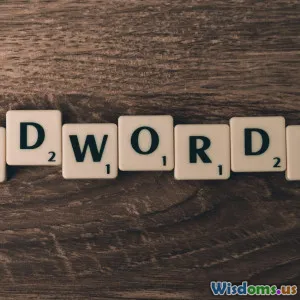
The Art of Persuasive Writing
7 min read Master the art of persuasive writing to captivate and influence your audience effectively. (0 Reviews)
The Art of Persuasive Writing: Unlocking the Power of Influence
Persuasive writing is more than just stringing words together—it's an art form that can shape opinions, drive decisions, and inspire action. Whether you're a marketer, content creator, or everyday communicator, mastering this skill imparts a significant advantage in crafting messages that resonate and convince.
Introduction
Imagine receiving a pitch that instantly grabs your attention, stirs curiosity, and compels you to respond. That’s the power wielded by persuasive writing. In a world saturated with content noise, clear and convincing communication becomes an invaluable asset. This article delves into the essentials of persuasive writing, unpacking techniques that transform ordinary messages into powerful dialogues that influence and inspire.
The Psychology Behind Persuasion
Successful persuasion hinges on understanding human psychology. According to renowned psychologist Dr. Robert Cialdini, persuasion is rooted in six key principles: reciprocity, commitment and consistency, social proof, authority, liking, and scarcity. Effective writers integrate these principles seamlessly:
- Reciprocity: Offering valuable information or benefits often encourages readers to reciprocate with engagement or compliance.
- Commitment and Consistency: Once readers commit to an idea, small or large, they tend to remain consistent in their beliefs.
- Social Proof: Showing that others endorse or use a product or idea helps develop trust.
- Authority: Citing credible sources or experienced individuals heightens a message's trustworthiness.
- Liking: People are more influenced by those they like or relate to.
- Scarcity: Highlighting limited availability motivates prompt action.
Understanding these mechanisms helps craft persuasive messages that appeal both logically and emotionally.
Structure: The Backbone of Persuasive Writing
A clear and compelling structure guides readers effortlessly through an argument:
1. Hook: Grab Attention
Start with a striking statement, question, or story to arrest interest. For instance, a non-profit might open with: “Every 10 seconds, a child goes to bed hungry—what if you could change that tonight?” This immediacy hooks readers emotionally.
2. Establish Common Ground
Demonstrate empathy and shared values. Establishing rapport makes audiences more receptive. A sustainable brand could express shared concerns about the environment.
3. Present the Problem or Need
Clarify what’s at stake. Effective writers spotlight a pain point or desire, heightening urgency. For example, detailing consequences of ignoring digital security breaches appeals to businesses’ need to protect assets.
4. Offer a Solution
Introduce your idea, product, or perspective as the ideal answer. Showcase benefits clearly and confidently.
5. Support with Evidence
Use data, testimonials, expert quotes, or case studies. Numbers speak volumes: “Studies show that content with persuasive elements boosts customer engagement by 54%.” This credibility bolsters trust.
6. Address Counterarguments
Anticipate objections, then refute them respectfully. This not only builds authority but also reduces doubt.
7. Call to Action (CTA)
End with a precise, compelling CTA: “Join us today,” or “Secure your spot now.” The CTA should empower readers to act immediately.
Language and Tone: Refining Your Message
The words you choose craft your message’s feel and impact:
- Use Clear, Concise Language: Avoid fluff and jargon. Precision fosters comprehension and respect.
- Incorporate Emotional Triggers: Words that evoke emotions—hope, fear, excitement—engage readers deeply.
- Active Voice Enhances Urgency: Compare “Mistakes were made” vs. “You made mistakes”—the latter is direct and impactful.
- Powerful Verbs and Vivid Imagery: Painting pictures stimulates reader imagination. For example, “ignite your passion” is more evocative than “increase your interest.”
Real-World Examples of Persuasive Writing
Case Study 1: Charity Campaign
The ALS Ice Bucket Challenge leveraged social proof and emotional storytelling, resulting in over $115 million donations globally in 2014. The campaign encouraged participation through social sharing and tagging, a brilliant use of social proof and commitment.
Case Study 2: Apple Product Launches
Apple’s keynote presentations masterfully combine simplicity, authority, and scarcity to persuade consumers. Presenters highlight innovative features as solutions, backed by expert knowledge, embodied in vivid demos compelling immediate interest.
Case Study 3: Political Speeches
Winston Churchill’s “We shall fight on the beaches” speech uses repetition, emotive language, and confident commitment to rally a nation during WWII. Here, persuasive writing bolstered morale and determined collective action.
Tips to Enhance Your Persuasive Writing Skills
- Know Your Audience: Research demographics, pain points, language preferences, and decision drivers.
- Leverage Storytelling: Narratives create emotional resonance and memories.
- Edit Ruthlessly: Trim unnecessary details. Quality trumps quantity.
- Test and Iterate: Use A/B testing to determine which messages resonate best.
- Use Social Proof Smartly: Incorporate testimonials from relatable sources.
Conclusion
Persuasive writing is a dynamic fusion of psychology, structure, and language, aimed at influencing minds and motivating actions. By understanding your audience, establishing clear value, and crafting compelling narratives supported by evidence, your words will transcend mere communication, evolving into instruments of influence.
In today’s information overload, persuasive writing isn’t just an advantage—it’s a necessity. When you write not just to inform but to inspire, to connect, and to prompt change, you embrace the true art of writing.
Ready to become a persuasive writer?
Try applying the principles outlined here today and watch your writing captivate and convert like never before.
References:
- Cialdini, Robert. (2006). Influence: The Psychology of Persuasion.
- HubSpot Research Data on Content Engagement (2020).
- Apple Product Launch Archives.
- Historic Speeches of Winston Churchill.
Rate the Post
User Reviews
Popular Posts


















